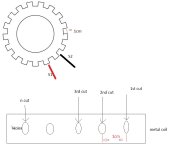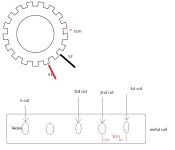adam_lhadi
Member
Why encremental encoder have a phase shift of 90°between A,B phases ,if it's 60° 30° what happen what's the difference ,can we change the 90°in TIA PORTAL
Why encremental encoder have a phase shift of 90°between A,B phases ,if it's 60° 30° what happen what's the difference ,can we change the 90°in TIA PORTAL
Hi bro90 degree offset between A and B channels means that the time between each event (rising A, rising B, falling A, falling B, rising A, etc) is the same for any given speed. Thus each event represents the same distance traveled if that's what you're measuring.
Why would you want it to be anything other than 90 degrees? In that case you would have to derate the maximum speed the decoder could handle based on the shortest time between events.
If there are ten mS between events at 90 degrees offset, channel A rises at 0 mS, channel B rises at 10 mS, channel A falls at 20 mS, and channel B falls at 30 mS, consistent 10 mS between events.
If the channels are offset by 60 degrees instead of 90, channel A rises at 0 mS, channel B rises at 6.6667 mS instead of at 10 mS, channel A still falls at 20 mS, channel B falls at 26.6667 mS instead of at 30 mS, so there are 6.6667 mS between some events and 13.3333 mS between others.

You may also find it informative or educational to create and encoder simulator in you software, you may use cyclic interrupt. I did that once for testing my code when I did not have the physical encoder. Not perfect but does the job.

the machine have a rotating pinion with two sensors as in picture those sensor never have the same state like 0.0 or 1.1,
whene you cut in the middle of the hole the next cut will always be in the middle of the next hole as long as you give positive integer number 1 2 3 4 5.....20.21.....
Hi BroI think I understand the application more.
That image is what used to be there and has been replaced with an incremental encoder.
So those switches have no relevance.
The machine cuts the plate exactly in the middle of each hole, or I should say it is required to do so.
And I think the holes are spaced evenly, so the plate must be prepunched.
There has to be a trigger that initiates the process and the distance from that trigger to the first hole must be know, after that it is pretty standard.
One more edit: and if the old setup had two switches that was probably to allow for an unequal distance between the holes. First hole cuts, them two cm later the other one. But the picture implies that they are evenly spaced so the second switch was not needed.
And yet another edit: now I am thinking the two switches were for precision, to fine tune the position with one switch.
